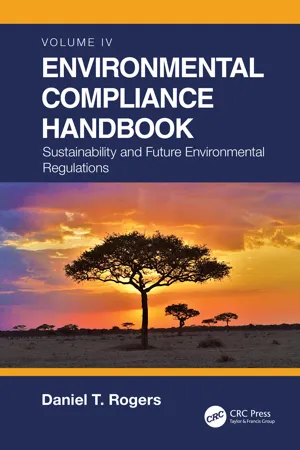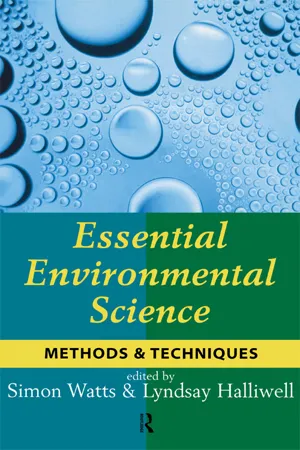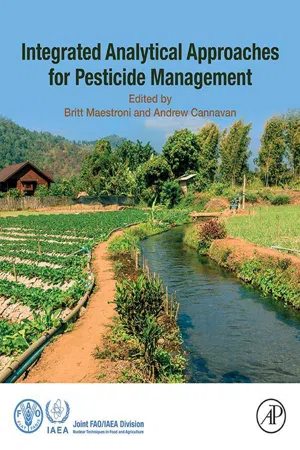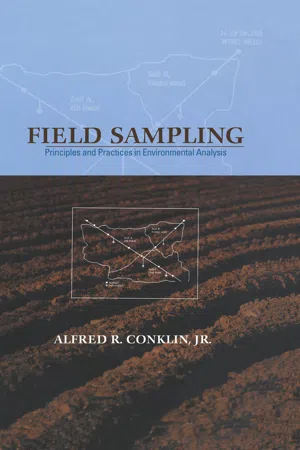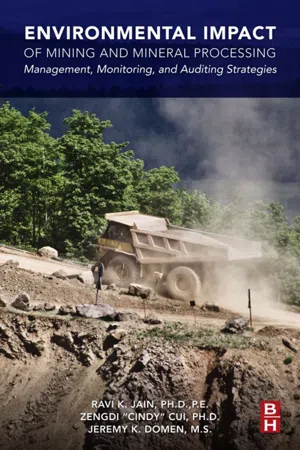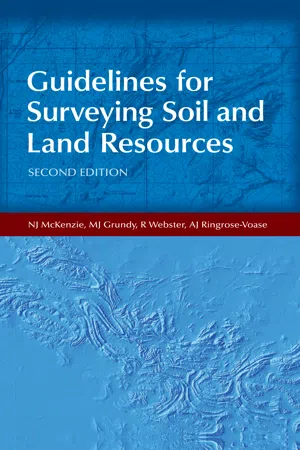Geography
Environmental Sampling Methods
Environmental sampling methods are techniques used to collect data on the physical, chemical, and biological characteristics of the environment. These methods include soil sampling, water sampling, air sampling, and vegetation sampling. They are essential for understanding the quality and health of ecosystems, identifying pollution sources, and assessing environmental impacts.
Written by Perlego with AI-assistance
Related key terms
Related key terms
1 of 4
Related key terms
1 of 3
8 Key excerpts on "Environmental Sampling Methods"
- eBook - ePub
- S. Mitra, Pradyot Patnaik, B.B. Kebbekus(Authors)
- 2018(Publication Date)
- CRC Press(Publisher)
2 Environmental SamplingWe might imagine a satellite which could scan the earth’s surface and provide a complete analysis of every part of the environment. This is, of course, in the realm of science fiction. Instead, we must collect representative samples of a small part of the environment in which we are interested, and analyze these to provide information about the composition of the area. For example, it is obviously impossible to analyze all the water in a lake, so portions of the water must be collected and analyzed to determine the true concentrations of materials in the lake. Similarly, to study contamination around a leaking underground gasoline tank, numerous soil samples are needed to map the extent of the pollution.We must keep in mind that only a small amount of sample (a few grams or milliliters) may be collected from a vast heterogeneous area. It is imperative that the samples collected represent the environment as accurately as possible. Major decisions are based on the results of the analyses. The steps involved in environmental sampling are:• Development of a sampling plan, including where and when samples will be collected and the number of samples required.• Collection of the samples.• Preservation of samples during transportation and storage.2.1The Sampling PlanThe importance of good sampling cannot be overstressed. The sample is the source of information about the environment. If it is not collected properly, if it does not represent the system we are trying to analyze, then all our careful laboratory work is useless. Care must be taken to avoid the introduction of bias or error.Sampling is done for monitoring purposes, as well as for research. Data may be collected to monitor air and water effluents or to characterize pollutant levels in environmental media (air, water, soil, biota). The objectives may be to comply with regulatory requirements, to identify long- and short-term trends, to detect accidental releases, or to develop a database or inventory of pollutant levels. Research may involve studying the fate and transport of pollutants or identifying pollutant exposures for humans and animals. It is important to design these studies scientifically so that they are cost effective and generate statistically significant information. - eBook - ePub
Environmental Compliance Handbook, Volume 4
Sustainability and Future Environmental Regulations
- Daniel T. Rogers(Author)
- 2022(Publication Date)
- CRC Press(Publisher)
Completion Study Quantitative investigation conducted to confirm the remediation at a site is sufficient and complete6.3 Common Environmental Sampling Methods
Sampled items during an environmental investigation typically include soil, groundwater, sediment, surface water, or air. The primary objectives when collecting any sample during an environmental investigation are: (1) collecting a representative sample and (2) ensuring the integrity of samples collected by taking measures not to contaminate or cross-contaminate the samples or alter any of the original properties of the sample (USEPA 1988).With these objectives in mind, acceptable sampling techniques have been developed by the United States Environmental Protection Agency. In addition, most states have published protocols for the collection of samples for environmental purposes. An overview of common sampling methods for soil, groundwater, sediment, and surface water are described in the following sections. In addition to sample collection requirements and guidelines, transportation or shipment of samples may be subject to Department of Transportation (DOT) rules described in Title 69 of the Code of Federal Regulation (CFR), Parts 171 through 179. Therefore, applicable local, state, and federal guidelines should be followed when conducting an environmental investigation at a specific site.6.3.1 Soil Sampling and Description
Soil sampling is usually initiated during the Phase II investigation and involves collecting surface and subsurface soil samples from soil borings drilled within and perhaps adjacent to RECs identified in the Phase I ESA. The number and depth of the borings is dependent upon the source and nature of contamination suspected to have been released. Soil samples are collected using a wide variety of methods, including: - eBook - ePub
Essential Environmental Science
Methods and Techniques
- Simon Watts, Simon Watts(Authors)
- 2003(Publication Date)
- Routledge(Publisher)
All that has been said about the desirability of random samples in the social environmental sciences applies equally to sampling in the physical environmental sciences. The difference is that, because of the nature of the physical system, random samples are very difficult to obtain (if possible at all). The following sections discuss the kinds of sampling frameworks available in the physical environmental sciences.see Section 2.22.3a Sampling in areas
Phenomena studied in the environmental sciences are often not accessible, individual ‘things’ which can be numbered and subjected to an ordinary probability sampling procedure. Geologists are perhaps in the worst position of all, as their subject matter is almost all buried at depth and they must take whatever evidence they can from outcrops or drill holes that happen to be available. Under these conditions it is very difficult to demonstrate that a sample is unbiased. In some branches of the environmental sciences populations are more accessible (like plants and animals), but the problem often is that they do not consist of identifiable and separate objects. Air, water, soil and rock are continuous media, and variables like air temperature, soil depth and water salinity are spread continuously. For this type of variable, location is often used as the basis of the sampling procedure. Consequently, measurements are taken at particular points, along lines or traverses, or in small areas (quadrats) (see Fig. 2.1 ).There are several methods for deciding the location of your sample points, traverses and quadrats. Here we shall describe the most commonly used methods for deciding the location of sampling points. The principles apply also to traverse and quadrat sampling. Fig. 2.2 illustrates the sampling designs.The methodology of simple random sample selection is given in Box 2.2 - Britt Maestroni, Andrew Cannavan(Authors)
- 2018(Publication Date)
- Academic Press(Publisher)
A practical aspect of sampling is that of data management. Environmental sampling is in this aspect not different from any other type of sampling. We may draw a parallel between environmental sampling and sampling on crime scenes. What is important for both scenarios is to keep the “chain-of-custody” from field measurements to final decisions (see the following text also). One important issue is that of the existence and implementation of a clear and simple sampling protocol. Sampling errors can be reduced by having prelabeled sample containers. Sampling in practice can be very different from the ideally designed sampling plan drawn up at the planning office. There must be an efficient risk management accompanying the planning of sampling both for the personnel and the samples.All information registered at the sampling site and that is relevant for future analysis must also be recorded and kept unchanged throughout the whole process of analysis and inference. Reasons should be given why some samples were not collected—this may be due to adverse weather or site access. Signed field sheets should at least be used, but agencies responsible for the sampling should encourage the use of portable tools (such as smart pads) to facilitate information gathering.References
1. ANZECC/ARMCANZ., 2000. Australian and New Zealand guidelines for fresh and marine water quality: Volume 1 - The guidelines. Australian and New Zealand Environment and Conservation Council and the Agriculture and Resource Management Council of Australia and New Zealand, Canberra and Auckland. (Available from: http://www.environment.gov.au/system/files/resources/53cda9ea-7ec2-49d4-af29-d1dde09e96ef/files/nwqms-guidelines-4-vol1.pdf ).2. Boswell MT, Patil GP. A perspective of composite sampling. Commun Stat – Theory Methods . 1987;16(10):3069–3093.3. Stratified random sampling. In: Cochran WG, ed. Sampling Techniques . third ed. New York: Wiley; 1977a; (Chapter 5).4. Systematic sampling. In: Cochran WG, ed. Sampling Techniques- eBook - ePub
- Li-Chun Zhang, Raymond L. Chambers(Authors)
- 2019(Publication Date)
- Chapman and Hall/CRC(Publisher)
Spatial statistics includes many techniques to study spatial phenomena, based on different analytic approaches and applied in many different fields, such as ecology, economics, epidemiology, image analysis and more [ 23, 25, 50, 54 ]. One of the contexts in which spatial aspects of units are very important is sampling theory. Here, the knowledge about locations of population units in a geographic space can be very helpful in studying phenomena characterised by spatial dependence and heterogeneity [ 2, 3 ]. Spatial sampling is a prosperous field of research that in recent years has produced several new methodologies. Basic sampling schemes include random, clustered and systematic methods, which take into account spatial information in the phase of sampling design. These methods can be applied according to different resolutions of the spatial information (i.e., cities, urban areas, neighbourhoods, regions) where the finest level consists of the individual point locations of the units, as identified by the spatial coordinates (namely longitude and latitude). Geographic coordinates are identified from information collected through Geographical Information Systems (GIS), which obtain, register, analyse and visualize geo-referenced data [ 13 ]. Moreover, the availability of spatial information about units leads to their use as an important auxiliary variable, which could be used as a strong informational component in, among others, stratification and estimation procedures. As said before, spatial sampling could have several applications in agriculture, environmental studies and, more in general, social science [11, 21, 28, 30, 44, among others]. In this chapter, we focus the attention on geo-referenced administrative data, such as, in particular, population and business registers in Italy - eBook - ePub
Field Sampling
Principles and Practices in Environmental Analysis
- Alfred R. Conklin, Jr.(Authors)
- 2017(Publication Date)
- CRC Press(Publisher)
The sample thus obtained is subjected to laboratory analysis. Both methods are valuable and sometimes essential in field sampling. Both have limitations, and the best sampling results are obtained when all ways of investigating the medium of concern are used. In all cases knowing the location of sampling activities is essential. Determining the location is best done using a global positioning system (GPS). Because of its importance, GPS will be discussed before examining either noninvasive or invasive sampling.In many cases noninvasive sampling is done before invasive or physical samples are taken, mainly because these methods show surface and subsurface features affecting the invasive sampling pattern. In some cases these methods are necessary for the safety of sampling personnel and buried utilities. They will thus be used to develop the invasive sampling plan. Because they will be used first they will be discussed before discussing actual invasive sampling.Data obtained by all sampling methods can be combined in a geographical information system (GIS). Combining data allows them to be both stored and displayed on maps of the area of interest (e.g., thematic maps). As many or as few data as needed can be displayed at one time. Additionally, a GIS system can relate data obtained from sampling to data obtained from other sources, such as aerial maps and soil surveys.5.1 General Sampling Considerations
Analytical and instrumental methods of analysis are very precise and accurate, but the results of analyses of environmental samples are not. This means that the variability comes either from the sampling procedures or during sample handling and storage prior to analysis. Sampling is the most important source of variability, and both the sampling and handling process must be carried out with great attention to detail.Sampling is the act of isolating a portion of a larger entity, analyzing it, and using the analytical results to describe the characteristics of the whole entity. In statistical terms the sample is an individual, which is a member of a family of similar individuals. Analysis shows that even environmental samples taken from sites close together may not be individuals or members of a family. When samples are taken at progressively increasing distances from a specific location they change in one of several ways. Characteristics can change gradually until a very different individual is identified, or they may change in a repetitive manner over long distances. - eBook - ePub
Environmental Impact of Mining and Mineral Processing
Management, Monitoring, and Auditing Strategies
- Ravi Jain(Author)
- 2015(Publication Date)
- Butterworth-Heinemann(Publisher)
Instrument selection and sample collection will depend on what type of sampling method will be utilized. Sampling methods can include the following:• Grab samples• Samples taken that represent a snapshot in time, typically collected by hand, although instruments are available• Typically used for homogeneous materials like water• May require transverse and longitudinal surveys to determine representative locations for sampling• May have to take multiple samples to account for stratification in bodies of water• Semi-continuous and continuous sampling• Automated instruments and sensors are used to collect samples for a given time interval specified by the needs in the monitoring plan• Sampling may be triggered automatically or manually based on various ambient conditions (e.g., rainfall, temperature, flow)• Care must be taken in sampler placement to ensure debris do not prevent sample collection• Samples may be many discrete samples, or a composite sample• Samples and data can be stored and collected during maintenance activities• Passive sampling• Devices that can be deployed in the field for a period of time, after which they can be collected and analyzed for a time averaged value• These systems are often low cost and can be deployed in large numbers to increase coverage• Passive sampling typically results in a composite sample• Remote surveillance• Instruments are used to collect data and communicate that data back to a station for analysis• Equipment can be very discrete or hidden to reduce vandalism or theft• Monitoring programs can include alarms when concentrations exceed limits specified by the monitoring planRemote sensing• Satellites or aircraft can be used to monitor changes in reflected or emitted radiation, though typically sunlight• Can collect data over an extremely large area• Can monitor areas that may otherwise be unreachableDifferent parameters will require different types of sampling methods. Sampling methods may be chosen based on site accessibility, site disturbance, frequency of sampling required, cost, potential hazards, and analysis techniques. It is important that samples be taken at roughly the same time period to reduce time dependent variations (e.g., diel or tidal variations). - eBook - ePub
- NJ McKenzie, MJ Grundy, R Webster, AJ Ringrose-Voase(Authors)
- 2008(Publication Date)
- CSIRO PUBLISHING(Publisher)
Most fieldwork in the mapping phase of detailed soil survey is done by free survey (see Free sampling) and in integrated surveys by representative sampling (see Representative sampling). Sound sampling improves confidence in observations and predictions. In qualitative survey, selection is an iterative process – preliminary information obtained from initial sites serves to condition further exploration. More intense observation and sampling will be needed where there is much diversity, and where hypothesised soil-landscape relationships are speculative, difficult to discern, or disproved. In many qualitative surveys, provisional map units are delineated during the research phase. During the mapping phase, confirm both the location of boundaries and allocation of the mapped areas to taxonomic classes. Record data that describe the soil and landscape features associated with the geographical units. At the same time, further develop your understanding of soil-landscape relationships and keep testing hypotheses – this will improve the efficiency and quality of mapping. Do this using reflectance patterns and features in imagery that relate to the appearance of bare soil, distribution of vegetation, land use and management, landform and hydrological features. If description and sampling were not costly, sites could be selected in every land unit tract; further observations could also be made to confirm or reposition soil and landscape boundaries. However, in most surveys, the size and number of map units will preclude this luxury and soil-landscape models will have to be used to predict attributes for each delineated area. Field sites serve many purposes and these include the following. Preliminary description of major types of soil and land. Identify these using the obvious patterns in remote sensing. Select sites to be representative of the patterns
Index pages curate the most relevant extracts from our library of academic textbooks. They’ve been created using an in-house natural language model (NLM), each adding context and meaning to key research topics.
Explore more topic indexes
Explore more topic indexes
1 of 6
Explore more topic indexes
1 of 4

